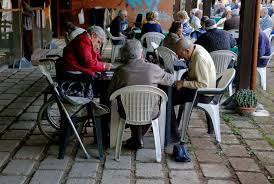Italian demographic decline: A threat to Italy’s future

Matija Šerić
Rome: The Republic of Italy, a country rich in history, culture, and art, is facing a severe demographic crisis that threatens its long-term political and economic survival. While many Western countries are dealing with a demographic crisis, and this issue isn’t new, the situation in Italy is particularly alarming.
Although Italy still represents a successful story and has one of the strongest economies—9th in the world by nominal GDP and 13th by GDP purchasing power parity (GDP PPP)—if negative demographic trends continue, the Italy we know may disappear. Instead of the familiar Italy, a new and perhaps unrecognizable version may emerge. Moreover, this is not just a possibility but a change that is already underway. Italy is dying, as Elon Musk accurately noted, at an accelerated rate.
The drop in birth rates is one of the most alarming aspects of Italy’s demographic crisis. This country, once known for its large families and a culture where children played a central role, now has one of the lowest fertility rates in the world. In 2023, Italy recorded a record-low fertility rate of 1.2 children per woman. In some Italian regions, the numbers are even worse. The worst off are Sardinia (0.91), Basilicata (1.08), Molise (1.1), and Umbria (1.1). The region that fares best demographically is Trentino-South Tyrol (1.42).
The fertility rate, which refers to the average number of children per woman, is far below the level needed to maintain the current population—2.1 children per woman. Demographers consider a fertility rate of 2.1 the golden standard because it allows for a stable population. Each person, i.e., each father and mother, replaces themselves with the necessary 0.1 difference to maintain a positive balance.

Last year, only 379,000 children were born. This is a 3.6% decline compared to 2022. Not so long ago, in 2010, nearly double the number of children—549,000—were born. The numbers would be even worse without a large number of foreign nationals. In 2023, 13.3% of newborns were children of foreign nationals residing in Italy.
On average, Italian women give birth to their first child at the age of 32, which is concerning because it reduces the fertile period and the possibility of having a second, third, and subsequent children. At the same time, 660,000 people died in Italy last year, resulting in a demographic deficit of 281,000 people. Since the 2014-15 school year, 2,600 preschools and elementary schools have closed due to the declining number of children. In the 2023-24 school year, 127,000 fewer children were enrolled compared to the previous year. If current trends continue, Italy will lose one million residents by 2030 (the current population is 59 million), and it will lose many more millions when the predominantly elderly population is taken into account.
One of the key causes of the declining birth rate in Italy is the stagnation of the Italian economy. High unemployment, especially among the youth, makes starting a family financially unsustainable for many couples. Unstable employment conditions, such as temporary contracts, poorly paid jobs, and a lack of stable, well-paying jobs, are insurmountable obstacles leading to a declining birth rate. Young people often delay marriage and having children until they achieve a certain level of financial security. Given the current state of Italy’s declining economy, this financial security is often achieved later in life or not at all. Without financial security for parents, there are no children.
In addition to economic factors, changes in social norms and values are also driving the demographic decline. Traditionally and historically, (large) families were the foundation of Italian society and a brand by which the Italian people were recognized, but contemporary generations have changed their priorities. New generations increasingly strive for individualism, career, and personal freedom (with great emphasis on free time) while neglecting traditional family values. Furthermore, social expectations and pressures on women to play traditional roles as mothers and wives are less pronounced, resulting in many women choosing to focus on other aspects of their lives.
Women, who previously had limited opportunities in the business world, now have access to education and career prospects, often motivating them to delay having children or reject motherhood altogether. In many cases, women face the choice between motherhood and a career. Given the unstable economic conditions, many choose to secure financial stability first and prioritize their careers, leaving children as a secondary consideration. The lack of family and societal support for working mothers also pushes many toward having only one or no children. In many cases, childcare responsibilities fall on mothers, further limiting their opportunities in the labor market.
The migration of people from rural areas to cities and the high cost of living in Italian cities are also significant drivers of the declining birth rate. In major cities like Rome, Milan, and Florence, housing prices are extremely high, and the cost of raising children is significantly higher than in rural areas. As a result, many couples decide to have fewer children or none at all to avoid the financial burden of raising a family in an urban environment. In rural areas, children had comfortable growing conditions on farms, while parents were entrepreneurs who could afford to feed their families. Such cases are increasingly rare today. The lack of adequate state support for families with children further exacerbates the demographic situation. Italy spends relatively little on children compared to other European countries. Measures such as parental leave, child benefits, and daycare subsidies are often insufficient, making it difficult for parents to balance work and childcare.
The aging population is one of the most prominent symptoms of Italy’s demographic crisis, with its implications spanning economic, social, and healthcare sectors. As one of the countries with the oldest populations in the world, Italy is facing a rapid increase in the share of elderly individuals in its total population, posing serious challenges to the sustainability of its society and economy. One of the key factors contributing to the aging population is the increase in life expectancy. Thanks to advances in medicine, public health, and living standards, the average life expectancy in Italy today exceeds 83 years, one of the highest in Europe. While this is a significant achievement, it means that more people are reaching advanced old age, increasing the number of elderly individuals in the country. This demographic change places significant pressure on the healthcare system, as older people generally require more medical care.
The unfavorable combination of a low birth rate and high life expectancy results in a significant imbalance between the number of older and younger individuals in society. Currently, about 23% of Italy’s population is over the age of 65, and this share is expected to increase further in the coming decades. Approximately 4.5 million Italians are over the age of 80, which is more than the 4.4 million Italian children under the age of 10. Italy is the oldest country in the European Union, with an average age of just over 48 years. These negative ratios and trends create serious challenges for the workforce and economic growth, as fewer young people are entering the labor market while more elderly people are retiring from it.
The aging population places enormous pressure on Italy’s pension system. With a growing number of people retiring and a shrinking number of working-age individuals contributing to pension funds, there is increasing concern about the sustainability of the pension system. Rising costs for pensions, healthcare, and social services for the elderly could further strain the national budget, requiring strategic planning and effective resource management. The current ratio of workers to retirees cannot be sustained without significant reforms, which may include raising the retirement age, reducing pensions, or increasing contributions. However, such measures could provoke discontent among the population, especially among the elderly, who are already facing increased economic insecurity.
The aging population has adverse effects on the healthcare system and social care. Older people are more likely to suffer from chronic diseases such as diabetes, heart disease, and dementia, increasing the demand for medical services and long-term care. Also, there is a need to adapt infrastructure, public spaces, and services to meet their needs. This includes accessible housing, adapted public transportation, programs that promote social inclusion and so on. The aging population generates direct economic effects. A shrinking workforce may slow economic growth, reduce productivity, and increase labor costs. Fewer young workers mean fewer innovations and entrepreneurial ventures, which could affect Italy’s competitiveness in the global economy.
Italy’s low birth rate has not been helped by the fact that since the fall of 2022, a right-wing conservative-traditionalist government has been in power, led by Prime Minister Giorgia Meloni. Although Meloni, as the leader of the Brothers of Italy party, promotes pro-natalist rhetoric, supports large families, and urges Italian women to have children—something she considers a patriotic duty (she uses the fascist regime’s motto—“God, Homeland, Family”)—she herself is the mother of only one child. However, the problem of low birth rates cannot be solved overnight, even with the best of intentions, as it is a very complicated and multifaceted phenomenon. Italy’s Prime Minister cannot resolve it even with the best ideas.
While in opposition, she and her party colleagues blamed Italy’s demographic decline on hidden globalist power structures (including George Soros) and supported the conspiracy theory known as the “Great Replacement.” According to this theory, which academic circles consider unscientific, the goal of secret centers of power is to replace Europe’s white and Christian population with non-white, predominantly Muslim peoples from Africa and Asia. Meloni continued the child allowance program introduced by the previous government in 2021 and slightly increased the monthly payments families receive for young children. However, her right-wing government introduced other incentives. The government reduced VAT on baby products to 5%, but this measure was later softened, and the VAT was raised to 10% from the beginning of 2024. Italy’s standard VAT rate is 22%.
The Italian government allocated one billion euros annually in the past and current year for various measures aimed at supporting mothers, including additional pension contributions for working women who have at least two young children. However, the key issues that need to be addressed are daycare facilities and low wages for parents. Daycares should be accessible to everyone, and wages, of course, should be much better. European Union assistance is more than welcome. The Italian government had planned to use part of the €200 billion from EU funds to build new daycare centers for 260,000 infants and preschool children, but Rome later reduced this target to 160,000. Meloni proclaimed a goal of 500,000 births by 2033. Regardless, much more will need to be done for the results to be tangible.
If Italy continues to lose its native population, the country will not be the same in the near or distant future. It will become unrecognizable. Some estimates suggest that by the end of the 21st century, Italy could lose half of its population, shrinking to a country of 30 million, mostly elderly, people. The shortage of workers in industry, agriculture, and the service sector has long been felt, and the labor shortage will only grow as there will be fewer qualified workers. However, Italy will not remain empty, as it is located in the strategically important and favorable position of the “soft underbelly of Europe.” In recent decades, Italy has seen an influx of migrants from Southern and Eastern Europe and Africa. These trends are expected to accelerate because, without foreigners, the Italian state will not be able to function. The only question is whether they will enter the country legally or illegally.
It would be better for Italy if migration occurred in an organized and legal manner, as it has been shown that many illegal migrants do not want to work but rather connect to the welfare system or engage in crime. However, a large number of new immigrants will pose new challenges for Italy, which will become a melting pot. In some areas, immigrants could outnumber the native population, which could bring new political challenges and strengthen separatist tendencies, which are not new to Italy (South Tyrol, Veneto, Lombardy, Sardinia, Sicily). The question is how much Italy, with, for example, 30 or 40% foreigners, will still be Italy in the classical sense. In any case, Italian authorities will soon have to initiate a demographic renaissance, or a whole host of new and very dangerous problems will follow.





